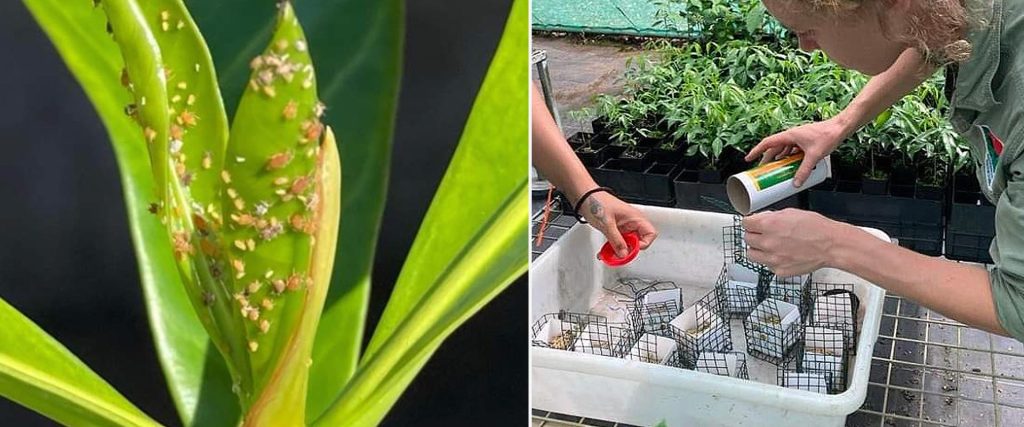Pioneering sustainable pest control in the Daintree

Aphid Infestation on a young plant in the Rainforest Rescue Native Nursery; Marine, Rainforest Rescue’s Native Nursery manager, preparing beneficial bugs for release.
How Rainforest Rescue’s Cow Bay Native Nursery is Using Beneficial Bugs to improve Habitat Conservation.
This article is a summary of a more detailed review of our Integrated Pest Management approach, which you can find in our soon to be released 2024 Annual Report.
Rainforest Rescue’s native tree nursery in Cow Bay, nestled within the Daintree Rainforest, has become an innovative hub for conservation. For over eighteen months, the new nursery has been nurturing young trees to support large-scale habitat restoration projects. With the capacity to grow up to 150,000 trees a year, a significant jump from the 12,000-capacity nursery at Diwan, this nursery is becoming a powerhouse for rainforest restoration. But as production scales up, so does the challenge of managing pests, a necessary consideration for keeping seedlings healthy and ready to plant.
Combatting pest problems
To tackle this, Rainforest Rescue has adopted an Integrated Pest Management (IPM) approach, which brings together a variety of pest control strategies, including biological controls, cultural practices, and selective chemical treatments. IPM allows the nursery to maintain tree health while minimizing additional harms to the environment which is a critical factor in such a biodiverse region.
Bearing in mind their remote location, the nursery staff have been developing key skills in pest identification, ecology, and management through online studies and knowledge sharing. By recognising pests early and understanding their life cycles, staff can act before infestations escalate. Tools like hand lenses and digital microscopes are essential in this process, helping staff spot even the tiniest pests, such as mites, and determine the best response.
Biological is best
To avoid reliance on chemical treatments, Rainforest Rescue has prioritised biological control methods. Thanks to a grant from the Albert and Barbara Tucker Foundation, the nursery launched a beneficial insect program. This allows staff to introduce natural predators and parasitoids to control pest populations, enabling a more harmonious and ecologically sound approach to pest control.
Some of the nursery’s beneficial bugs include:
- Green Lacewing (Mallada sp.): This native predator is a versatile pest controller, taking on aphids, caterpillars, moth eggs, scale insects, and mealybugs.
- Ten-Spotted Ladybird (Harmonia conformis): Known for its appetite for aphids, the Australian ladybird beetle larvae will effectively reduce aphid populations around the nursery.
- Parasitic Wasp (Aphidius colemani): This tiny wasp targets aphids, laying eggs inside them. The eggs hatch, and the larvae consume the aphid from within, eventually emerging as adult wasps.
- Bacillus thuringiensis (Bt): This naturally occurring bacterium targets caterpillars, which threaten the nursery’s young seedlings, producing proteins that disrupt their digestive systems.
These plants will provide essential food sources, allowing beneficial insects to establish themselves and continue supporting the nursery’s pest management efforts.
Though the nursery strives to minimise chemical use, certain pests like Myrtle rust, a fungal disease that affects the Myrtaceae family require selective chemical treatments. Early detection through scouting helps reduce the amount of chemical needed, and whenever possible, the nursery chooses products with lower toxicity to protect both beneficial insects and the broader ecosystem.
A Daintree first?
Developing an IPM system suited to the unique environment of the Daintree has been a process of research, experimentation, and dedication. With few precedents for sustainable pest control on this scale in such a biodiverse area, Rainforest Rescue has had to build much of its knowledge from scratch. However, early results are promising – aphid infestations have decreased significantly thanks to lacewing and ladybird releases, and mite control is showing progress as new growth on treated plants appears healthier.
One of the biggest challenges facing the nursery is financial. Traditional chemical pesticides, though cheaper, do not align with Rainforest Rescue’s commitment to conservation. Biological controls, on the other hand, are more expensive. The support from the Albert and Barbara Tucker Foundation has been invaluable, helping Rainforest Rescue pursue sustainable pest management that aligns with their mission to protect the rainforest.
As Rainforest Rescue continues to refine its IPM strategy, the nursery is building a database of best practices and results. This information will not only benefit future restoration efforts within the Daintree but also serve as a valuable resource for conservationists worldwide.
In every step, from pest identification to monitoring the success of beneficial insects, the Cow Bay nursery demonstrates how a thoughtful, ecologically balanced approach can protect both young trees and the remarkable biodiversity of the rainforest.
Through dedication and innovation, Rainforest Rescue is not only growing trees but also setting new standards for sustainable reforestation in one of the world’s most precious ecosystems.
Authored by Dan Miller, an intern of Rainforest Rescue, with input from our Native Nursery Team.
Want more good Rainforest news in your life?
Subscribe to our eNews | Follow us on Instagram | Like us on Facebook | Subscribe to our YouTube channel
Help Protect Rainforests Forever
Donate to Protect Rainforests Forever | Become a Rainforest Guardian for as little as $2 a month | Partnership Options

